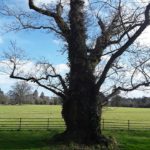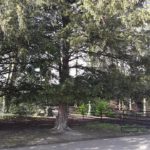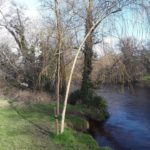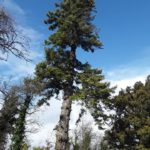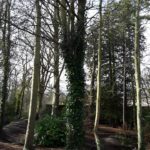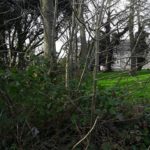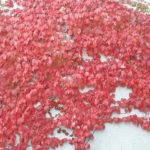Welcome to our Harry Potter inspired tree walk!!! JK Rowling knew her tree folklore; you find it in the Harry Potter books. Each wand is made from a tree that often reflects the qualities of the wizard!
Oak Tree
First up is the oak tree. This tree is on the lime avenue and is the only oak on a long row of lime trees! The oak is the king of the forest and is big and strong! In Castletown, it stretches up and out, protective over our Avenue, giving shelter to animals and birds. If you look closely you will even see a bird box. Can you guess whose wand is made from the oak? Big, strong and a lover of all animals? It can only be…. Hagrid…. our oak tree may have a rough gnarly bark but it is vital in feeding and sheltering wildlife. A fully grown oak tree could be home to over 300 different types of insects!
We have other oak trees at Castletown. There are a few different ways to recognise the oak tree. We will share three with you! Firstly, keep a close eye on the bark. The bark of a young oak is gray, smooth and thin. As the tree gets older, the bark becomes rougher, scalier and changes to a black-brown colour. Next up, the leaves. Their leaves are around 4-5cm long with 4-5 deep lobes (like ear lobes!). The fruit of the oak tree is called the acorn. They fall from the trees around September.
Yew Tree
This picture of a yew tree was also taken on the avenue. Note its rough reddish bark and soft needle like leaves. He Who Must Not Be Named had a yew wand… and that brings us to the question why the yew tree? Well, the yew tree has an interesting history. It is believed to be associated with long life and even eternity because it lives so long! Hardly, a wand for a wizard like he who should not be named! Ah yes, but that is where the folklore of this tree gets a little interesting! It lived for such a long time people associated the yew with eternity and planted it near graveyards! This also helped keep certain animals away… how you may ask? Well its berries are poisonous! Perhaps as a result of this, the yew tree came to sit uncomfortably between life and death!
Indeed, many parts of this tree are very poisonous so stay well away. It is no wonder He Who Must Not Be Named wand was yew! Now, I for one, am done saying He Must Not Be Named, it is rather long winded and silly. Let’s have courage and use this horrible wizard’s name…. Voldemort! As powerful and as clever as he was Harry had something Voldemort did not! True friends and friendship.
As Harry said to Voldemort, ‘You’re the one who is weak. You will never know love or friendship. And I feel sorry for you’. That is true power right there! And SPOILER ALERT…that was the only reason Harry defeated him.
P.S. not to give the yew tree bad press… yew is currently being used in cancer research. Apparently, Ginny Weasley also had a yew wand.
Willow Tree
Another incredible tree is…the Willow! At Castletown, we have a weeping willow! You will see them down by the river. They have long dropping branches and long thin leaves! We first posted about the remarkable willow on Mother’s Day because Harry’s brave mother Lily had a willow wand. Its properties are entirely appropriate for mothers everywhere.
One of its most valuable traits is its flexibility, it can bend and sway in all kinds of ways to avoid breaking. When the wind gets rough, the willow just bends with it and stays strong! The willow, while it likes wet soil best, can survive in drought too. And the willow tree can grow really easily, just one branch stuck into soil will take off and grow all by itself.
The willow trees bark also contains salicin, which can be used to make salicylic acid, the active ingredient in aspirin and ancient peoples used to chew on the bark to relieve pain and inflammation.
Willow has been used for centuries to make all kinds of useful things like fences, baskets, fishing nets and furniture. It was used in building to make wattle and daub walls.
In folklore, the ancient Chinese believed it could ward off evil spirits and ancient Celtic people had a custom that if you knock on the trunk of a willow tree, you can ward off bad luck, leading to the phrase ‘knock on wood’
The willow tree also provides a valuable habitat for insects, moth and butterfly caterpillars love to eat their leaves and bees collect pollen from their furry catkins to feed baby bees in Spring. It gives shelter to animals such as squirrels and hedgehogs as well as food and is a very important part of the biodiversity at Castletown.
So, as we celebrated mothers everywhere, the strong, brave and flexible protectors of their children, we remembered that Lily’s love and self-sacrifice for her son Harry enabled him to defeat the greatest threat the wizarding world had ever known. In the words of the great Dumbledore, ‘Love as powerful as your mothers for you, leaves its own mark’
Fir Tree (Silver Fir)
Now, to take a closer look at our fir tree or silver fir (Abies Alba) to be more exact. The fir tree in this photograph is one of the tallest in the park. So look up for it! Professor Macgonagall’s wand is made of fir wood and she is one formidable woman!! The fir tree is strong, preferring cold climates. Its leaves are needle-like giving it a prickly exterior, however, this tree has won the hearts and minds of us all. Apparently, it was one of the first Christmas trees, bringing joy to many. Even in folklore, this tree has a reputation as a big softie. It gave shelter to a little bird looking to survive the winter when all the other trees refused. As a reward for the fir tree’s kindness, it got to keep its leaves during the long months of winter! I think we can safely say that like the fir tree, MacGonagall may have a tough exterior but we all know she has a heart of gold!
Hornbeam
The next tree is the Hornbeam. The hornbeam has a pale grey bark with vertical markings. So which Harry Potter character has a Hornbeam wand? Drum roll please! The answer is Quidditch champion… Victor Krum! Given that the Hornbeam is known for its strength and has even been used by the Romans in the making of chariots, it is little wonder Krum is associated with it! (Spoiler Alert) Krum represented Bulgaria, his native country, in the Quidditch Championship Final.
Now many of you non Harry Potter fans may have no idea what Quidditch is, just know that the Irish beat the Bulgarians in that fateful game! Yet Krum’s status as a champion came in the face of that defeat. When he realised his country had no hope of winning, he still didn’t give up. Krum continued to perform at his very best. In fact, he was such an exciting player especially when the odds were stacked against him, that some of his opponents cheered for him!
In many ways, we may all feel the odds are stacked against us sometimes, that things are beyond our control. We must not forget though, like Krum, we can choose how we respond to them! Let’s rise to the challenge and be champions in our own lives.
Ash Tree
Today’s tree is the ash tree. Look out for the smooth greyish bark on young ash trees. The older trees have a darker, rougher bark. Keep a sharp eye out for our ash trees. Young ash trees have a greyish smooth bark.
Most of us are probably familiar with ash & its use in hurley making. One of the important things about hurling is it is a team sport. You cannot shine on your own. It takes a team to play it & whether you are a goalie, on the back line, mid field or a forward, each person plays their part. The champions need their team to shine!
This brings us to Ronald Weasley. Ronald Weasley’s wand was made of ash. And there is arguably no better team player than Ron! I mean yes, he had his moments. Wouldn’t you if your best mate got all the attention! And I mean all the attention! Yet Ron was there when it counted, when the chips were down and Harry was in real trouble! Champions cannot shine without the team behind them!
Right now, during this pandemic, we are all on the one team, standing together when the chips are down. So yes, we may have social distancing but in the words of Robert Frost, ‘men work together, I told him from the heart, whether we work together or apart’.
Elder Tree
The next tree is the elder tree. We have a picture of the young elder here but as they grow, their bark becomes deeply furrowed. In folklore the tree has had a rather uncomfortable reputation representing the cycle of life & death. Perhaps, then it is no wonder that the elder wand in Harry Potter is the same! (Spoiler alert) Its allegiance changes!!
For now, we will focus on Dumbledore as master of the elder wand. Boy, did Dumbledore have, like this tree, a colourful (and questionable) history. I mean, I do not want to say this but he was not the nicest of people! Yet Dumbledore’s past and the pain of his past, the hurt he had caused and had to accept he caused; opened the door to wisdom.
Like some plants, Dumbledore needed a good pruning to become the character we came to know and love!! To end with a quote from Dumbledore; ‘Happiness can be found even in the darkest of times if one only remembers to turn on the lights’.
Vine
A vine is a plant whose stems require support. As you can see from this picture, this vine is snugly growing against one of our walls! Now which Harry Potter character has a vine wand?? The answer is Hermione!! I found this a tough match considering Hermione is such an independent character!! And she not only fends for herself but she keeps the others in check. I mean when she turns to Harry and says, ‘I’ve always admired your courage Harry, but sometimes you can be really thick’, hardly sounds like a person leaning against anyone for support!!
Yet, in many ways, intentional or not, that connection is profound. Hermione, at the start of the series, was not a likeable character. She relied on herself and her cleverness, not letting anyone close to see her fears and vulnerabilities! It is not until she had no choice and needed help, did she open the door to true friendship! In other words, she had to depend on others!
Of course, independence is important but in the words of John Donne, no man is an island. When a vine is properly supported it thrives! So do not forget, recognising our vulnerabilities, particularly in times of trouble can help us. In many ways, we are all vines in need of the wall of true friendship!

